#chaetura
Explore tagged Tumblr posts
Note
Since Google has gone to ai shit and I don't trust it I'm gonna ask you what do swifts eat? Like chimney swifts cus I know they have really tiny legs and spend a bunch of time flying so I'm guessing they eat flying insects

Chimney Swift (Chaetura pelagica), family Apodidae, order Apodiformes, IN, USA
photograph by Peter F.
In general, swifts eat flying insects, yes. Chimney Swifts feed on a wide variety of flying insects (from small aphids and gnats to larger beetles, wasps, and dragonflies).
190 notes
·
View notes
Photo

Chimney Swift (Chaetura pelagica)
© Peter F
351 notes
·
View notes
Text
BOTD: Vaux's Swift

Photo: Nancy Palmer
"A small, dark aerialist of the west, often overlooked as it flight high over northwestern forests or low over lakes and rivers with stiff, rapid wingbeats. Similar to the well-known Chimney Swift of the east, but only occasionally nests in chimneys. Because of its reliance on large hollow trees for nest sites, it has become scarce as old-growth forest in the northwest has been destroyed."
- Audubon Field Guide
#birds#vaux's swift#birds of north america#north american birds#swifts#birds of the us#birds of canada#birds of mexico#birds of central america#birding#bird watching#birdblr#birblr#bird of the day#Chaetura vauxi
75 notes
·
View notes
Text

Hirundo rustica | Progne subis | Petrochelidon pyrrhonota | Chaetura pelagica | Tachycineta bicolor
Plate XVIII | Die Nordamerikanische Vogelwelt (1891)
#bird art#bird illustration#vintage art#vintage illustration#artists on tumblr#hirundinidae#hirundo rustica#barn swallow#progne subis#purple martin#petrochelidon pyrrhonota#cliff swallow#chaetura pelagica#chimney swift#tachycineta bicolor#tree swallow
13 notes
·
View notes
Text

#546, a chimney swift.
Requests for birds are open, updates happen on Thursdays. [project tag] | [kofi] Find me on: [twitter]
34 notes
·
View notes
Photo

A new variant has been added!
Sick's Swift (Chaetura meridionalis) © Miranda85
It hatches from brown, migratory, ochre, pale, short, small, and swift eggs.
squawkoverflow - the ultimate bird collecting game 🥚 hatch ❤️ collect 🤝 connect
3 notes
·
View notes
Text
Not gonna lie, that's the most adorable thing I've seen being shifted as. That's amazing and fills my heart with joy. May I cuddle you in such shifting moments? :D
chimney swifts are so weirddd theyre like if birds decided to be bats.
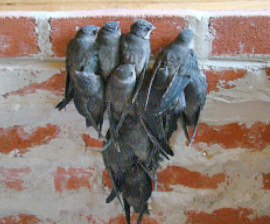



thats bats. those are bats. to me
62K notes
·
View notes
Text
VENCEJO CHIMENEAS
CHAETURA PELAGICA NOMBRE CIENTÍFICO: CHAETURA PELAGICA. LONGITUD: 12 A 15 CM. PESO: 19 A 25 GRAMOS. PLUMAJE: SIMILAR ENTRE AMBAS SEXOS. MIGRACIÓN: MIGRATORIO. ESTADO: COMÚN. UBICACIÓN: NORTEAMÉRICA, NOROESTE DE SUDAMÉRICA. ESTE VENCEJO PEQUEÑO DE COLOR MARRÓN AHUMADO ES EL ÚNICO QUE SE REPRODUCE AL ESTE DE NORTEAMÉRICA. CONSTRUYE UN NIDO PEQUEÑO EN FORMA DE MEDIA TAZA COMPUESTO POR RAMITAS,…

View On WordPress
0 notes
Text

sick's swift (Chaetura meridionalis) by Walmir Leitzke
0 notes
Text

Vaux's Swift Chaetura vauxi
5/4/2023 Orange County, California
#vaux's swift#swifts#swift#bird#birds#bird photography#birblr#wildlife#wildlife photos#wildlife photography#nature#nature photos#nature photography#birding#birdwatching#birding photos#my photos#california#california wildlife
51 notes
·
View notes
Text
I've been celebrating my return to Portland by going out and doing things I was too busy for when I lived here before. Last night I finally made it out to see the vaux's swifts (Chaetura vauxi) at Chapman Elementary School. Every September evening--and even into October--they arrive en masse at dusk to spiral into the chimney for a safe place to sleep.
This phenomenon started in the 1980s after the wholesale clearcutting of old-growth forests removed most of the natural hollow snags the swifts roost in. The school stopped using their heating system while the swifts were there, and two decades ago Portland Audubon (now Bird Alliance of Oregon), who organizes the swift watches every year, donated a new heater that didn't make use of the chimney, which is now solely maintained for the swifts.
Enterprising predatory birds, like Cooper's hawks (Astur cooperi) and peregrine falcons (Falco peregrinus), will perch at the mouth of the chimney and pick off swifts for an easy meal. Last night there was a Cooper's taking up the spot, and you could tell the swifts were quite wary, not wanting to risk flying too close. I watched this hawk catch three swifts, and managed to get the last one on video, seen here; it flew off shortly thereafter, and the swifts immediately dove into the chimney.
#Chapman swifts#swifts#vaux's swifts#birds#birdblr#ornithology#nature#wildlife#animals#hawks#cooper's hawk#death#animal death#Portland#Portland Oregon#Oregon#PNW#Pacific Northwest
52 notes
·
View notes
Text
The State Birds Initiative: Georgia (#4)
Welcome to the fourth official poll of the State Birds Initiative! Before the poll, though, one thing real quick. My suggestion is that you read the post below before voting in the poll below. That's especially important if you're lacking any context about the birds being presented as the new (or old) State Bird of the Peach State, Georgia. This is to be fully informed as to why these are being presented, and to make your choices appropriately. Lastly, some of these birds, you will notice, may go against some of the rules listed in the introduction post. All is explained after the jump where the explanations are, I promise you that. But with that...OK! Here's the poll!
With that...time to put Georgia on our minds!

Georgia! State of peaches, Coca-Cola, pecans, and civil rights! Home of Ray Charles, Jimmy Carter, Jackie Robinson, and the great Martin Luther King, Jr.! Location of the only whale shark in captivity in the country, the historic Forsyth Park of Savannah, the majestic Stone Mountain, and the first Chick-fil-A! And for our purposes here in the State Bird Initiative, it's also the first state we're looking at with a tropical climate! Well, a humid subtropical climate, actually, but it counts! If you've ever been to Georgia (which I haven't as of yet, but I'm working on that), you probably know that Georgia is a bit sweaty and temperate most of the year, with long humid summers and high water levels.
In terms of the ecology of the state, we're looking at swamps, cedar-dominated, as well as having a decent proportion of pine trees. Actually, to be specific, we're looking at forests of Longleaf Pine (Pinus palustris), an large endangered pine tree species endemic to the southeastern United States. Now, to be clear, this species isn't specific to Georgia, and it's actually the state tree of Alabama. However, now that we've hit the southern USA, we have to address it, as the tree is a symbol of the region. The actual state tree of Georgia is another iconic tree to the southeastern USA, the Southern Live Oak (Quercus virginiana), another big tree evolved to be resistant to forest fires, saltwater, and hurricane-force winds common in the area. Famously, the Southern Live Oak trees of St. Simons Island, Georgia was harvested for the density of their wood, which made them particularly strong against cannonballs. Said wood was used to construct the famous U.S.S. Constitution, AKA "Old Ironsides", which was said to have cannonballs actually bounce off of it throughout the War of 1812. Said ship is still in Boston Harbor to this day, making the 227-year old ship the oldest still floating naval warship in the world! And that's all thanks to the natural environment of Georgia.

What about Georgia's culture? Historically, of course, Georgia is complicated as hell. A former seat of the Civil War and the Confederacy, the state has seen heavy reconstruction in the last century and a half, eventually becoming associated with many civil rights heroes, and currently having a few prominent bastions of the Democratic Party, such as Atlanta. On a contemporary level, the state is famous for its music, its accents, and its food! The state has at least four foods as state symbols - peaches, peanuts, grits, and the Vidalia onion, and has other iconic food and drink like sweet tea, cornbread, peach cobbler, and fried catfish.
As for its people, they're a highly religious bunch on average, known for their hospitality and, according to some accounts online, "polite sarcasm". Y'know, "bless your heart" and all that. Conservative historically with an increasing population of Black Democrats in metropolitan centers, it's a growing state in terms of diversity, and changing rapidly. So...a culturally diverse bird that lives in oak trees? Yeah, that's a target we're gonna hit for sure. I mean, the oak or pine tree part is pretty easy, but the other thing? Well..a songbird would make some sense. I mean, the state is famous for its musicians, ranging from OutKast to Gladys Knight to 2 Chainz to Luke Bryan, and more. So, something that sings is a solid choice. There are a couple of other qualities we can go for, but that's enough for now, I think.

With that, let's move onto the choices. Got some interesting ones this time, but I have...a hunch about this one. We'll see how this goes, but I have a feeling it's gonna go the way of New Jersey's poll, which has been...decisive. But OK, with that...birds after the jump!!!
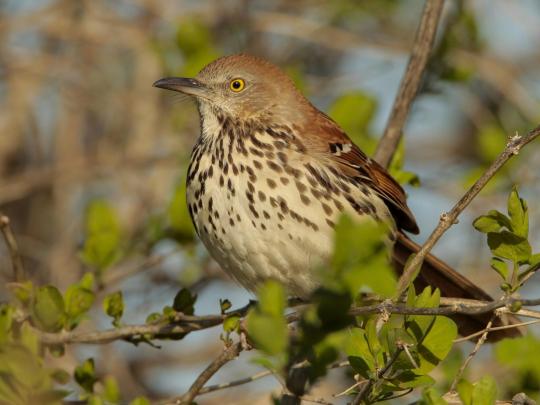
Brown Thrasher (Toxostoma rufum)
Not gonna lie - this one could be hard to beat, surprisingly. Which is too bad for a number of reasons, but the Brown Thrasher (Toxostoma rufum) isn't really a horrible choice for Georgia's State Bird. It breeds in the state, even though it's found all over the eastern and central USA. It's an iconic bird in sight and sound, which is pretty important for a state that's produced a lot of human singers. I even mentioned up above that a songbird wouldn't be a bad choice, and what better songbird than one who can memorize, mimic, and remix multiple sounds for its own use? Plus, it was chosen by school kids, meaning it was elected by the public. Of course, to be fair, it was also chosen by governor at the time, Eugene Talmadge, a famous white supremacist who enforced segregation in Georgia schools and universities, openly supported Adolf Hitler, and was a genuinely extremely racist PIECE OF SHIT...but I digress? Although, it is extremely ironic that Talmadge ratified the Brown Thrasher as the State Bird of Georgia, so there's that.
OK, Talmadge doesn't really have anything to do with this, I just needed to get some anti-racist anger out for a second there, sorry; dude was a bastard in a lot of ways. But in terms of the Brown Thrasher, it's honestly not a bad choice for Georgia. Thing is...I'm not entirely sure I can say it's the best choice, or even a really good choice, frankly. It's...a choice. It does eat peaches, though, so maybe throw that into the pros pile for the species. Oh, and one more thing: it's defeated an attempt to depose it before. The frankly kinda ridiculous attempt to change the State Bird of Georgia to the Cornish Chicken in 2010 was not received well for the chicken. Georgians liked their Thrasher too much! Also, one of the arguments against the Brown Thrasher that the Flip the Bird movement put forth was that it "has no contribution to the state of Georgia economy". Of all the stupid goddamn arguments...
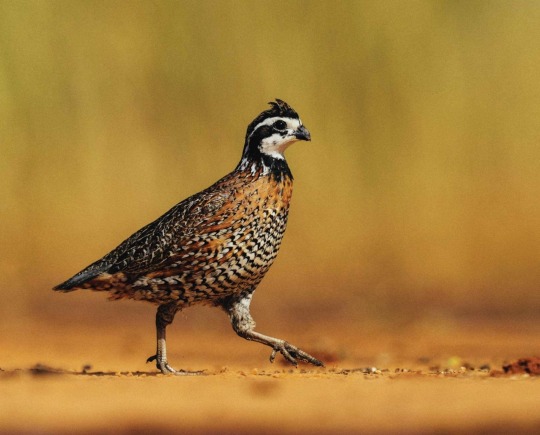
Northern Bobwhite (Colnius virginianus)
Well, if we're talking about the incumbent State Bird, we should bring up the incumbent State Game Bird as well! Yeah, this'll be a regular thing going forward. Any ornithological state symbols are up for bid and re-election, although this is a slightly different process. If a State Game Bird is elected as State Bird, it will ascend to that post, and a new State Game Bird will be proposed, possibly with a new poll. However, if it is not the chosen State Bird, it'll remain as the State Game Bird. So, really, the Northern Bobwhite gets to stay where it is...for now. This may change as we get overlapping game birds across the USA. And we will, believe me. With that said, let's talk about the Northern Bobwhite (Colinus virginianus).
A member of the New World quails (Odontophoridae) the bobwhite is named after its iconic whistling call, and not a random dude named Robert White. The Northern Bobwhite isn't the only species of bobwhite quail by any means, but it's the only major native representative in the USA. It's a grassland and open forest-loving quail whose range extends from Texas to Massachusetts...kind of. Here's the problem with the bobwhite: its population is rapidly decreasing. In the past 60 years or so, the population's decreased by at least 85% in its native range, which is...A LOT. It's partially for that reason that the species is on my priorities for my Life List, because I've never seen them, and they're rapidly vanishing.
youtube
That, alongside the normal ecological concerns and links, and its relatively new status as a threatened species due to land use and forest fires, makes it a good candidate for recognition on its own. But is it a good bird for Georgia? Well, only 4% of its breeding population is found in the state year-round, making the state a poor reservoir for the species. There's also a point that the bobwhite is, surprisingly, an invasive species in some countries, specifically New Zealand and Italy. They're also a common bird in captivity, even though any aviary should have them be the only ground-dwelling bird, since they can be aggressive to competitors. That said, they're not a completely doomed species.
More importantly, though, the fact that Georgia doesn't have a lot of these guys immediately makes them a less-than-ideal candidate for State Bird. State Game Bird, though? That might actually be worse. Remember, this is an endangered species, meaning it may not be a bird we should glorify as a food source. In fact, the Georgia Department of Natural Resources has conservation measures in place to protect bobwhite and their habitat, also seeking to restore it and add new potential habitats for the species. And they aren't eliminating hunting of the species, but are strictly managing and monitoring populations. And there is merit to managed hunting, for the record, but that's a separate conversation to be had. So, not a horrible choice to remain as Game Bird. But who knows? Maybe I'll make a separate poll to ask this question after all. If that's something that interests you, let me know! For now, let's move on.
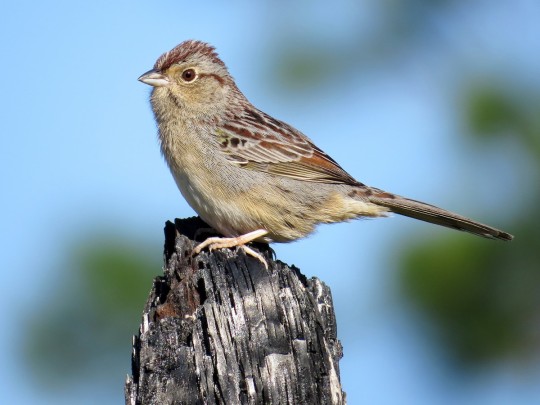
Bachman's Sparrow (Peuacea aestivalis)
On to the eBird suggestion! And this one is...ooooooooh...yikes. OK, yeah, you may remember my issue with the Saltmarsh Sparrow (Ammospiza caudacutus) as a potential State Bird for New Jersey, mostly revolving around the idea that it wouldn't be easily recognizable by the public, unaffiliated with sparrows and their subtle or major differences. This? This is worse. Once again, don't get me wrong, Bachman's Sparrow (Peuacea aestivalis) would be a dream for me as a birder, as a southern exclusive species and a lifer for me personally. But for the average layman? This is a bird difficult to identify for birders! Not sure the average non-bird person has a chance, to be honest.
But just to be completely comprehensive, why the Bachman's Sparrow? Well, the eBird article quotes the species as having a large breeding population in Georgia. However, to be completely fair, the species mostly breeds in Florida, not Georgia (48% vs. 30%, by recent calculations). That said, the number of Bachman's Sparrows breeding in Georgia isn't a number to sneeze at. As for its ecology, it specializes in pine forests, including those composed of longleaf and loblolly pine, which have Georgia as a major habitat. Oh, and on a historical note (not that this matters too much), John Bachman was an opponent of segregation and racist eugenics beliefs, so a lot better than other historical figures with birds named after them. Granted, that bar is buried seven feet beneath the Earth, but still, it's cleared in this case. So, not the worst set of reasons for Bachman's Sparrow to make the cut.

Savannah Sparrow (Passerculus sandwichensis) Swamp Sparrow (Melospiza georgiana)
Whoa whoa whoa, hold on, hold on. Two more sparrows? What is this, karma? Well, yeah, maybe. Of course, these two are chosen based on their names, as both specimens used in the descriptions for the species were collected in Georgia. But does this truly matter in this case? Neither the Savannah Sparrow (Passerculus sandwichensis), nor the Swamp Sparrow (Melospiza georgiana), breed in Georgia, although both are still found in the state. If I had to argue one over the other personally, it'd be the Swamp Sparrow, both to represent a dominant habitat in the state, and because they're possibly more recognizable...even though they're pretty close to the Song Sparrow (Melospiza melodia) to the untrained eye, I suppose.
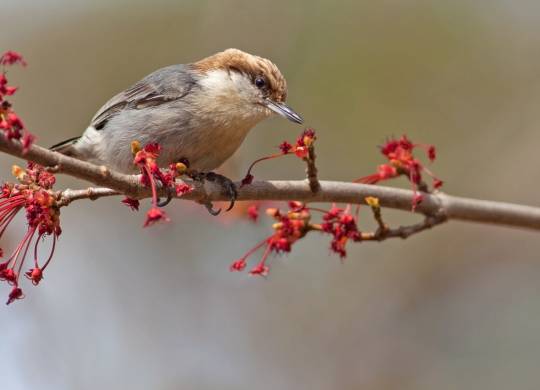
Brown-headed Nuthatch (Silla pusilla)
See, here's the real question about the eBird choices. Why choose the Bachman's Sparrow, when the adorably charismatic Brown-headed Nuthatch (Silla pusilla) was right there? The largest breeding population of this bird's global range is in Georgia, with a full 26% of the species depending on Georgia for its propagation. Yeah. This is definitely a Georgia breeder, but since the Bachman's Sparrow is a bit more endangered, has different living conditions, and is a bit more dependent on its Georgia population than the nuthatch here, that's likely why it was given the crown.
And yet...AND YET...in my opinion, this is the better state-dependent representative for Georgia. Sure, less of its breeding population is found in Georgia, but one-quarter of its global population isn't exactly something to sneeze at. And, importantly, this is where the majority of its population is housed, making Georgia more important for the Brown-headed Nuthatch than it is for the Bachman's Sparrow. But is it a better representative outside of that point? Well, it's recognizable, it's not terribly difficult to find, and it's certainly charismatic. I mean, look at that thing, it's cute as hell! Not that the sparrows aren't cute in their way, but the nuthatch? I wanna squeeze that thing, and apparently, they actually sound like rubber duckies. And no, charisma doesn't always mater, and it can be damaging for noncharismatic species conservation. But it can help.

Anything else? Well, using the same logic I have with other birds, it's an important representative of its habitat. The pine forests of the Southeastern USA are, unsurprisingly, in trouble. In fact, longleaf pine forests are kind of a massive deal from a conservation standpoint, and they're in a massive amount of trouble due to development and climate change. Some figures calculate a 95% loss of these forests by 2080, which is...bad, it's real bad, obviously. That kind of potential danger to their habitat, combined with their role within it, makes the nuthatch a good option. And apparently, Birds Georgia agrees with me.
Birds Georgia, for the record, is formerly known as the Georgia chapter of the National Audubon Society. And, while they still have affiliation to the organization, they've separated themselves from the legacy of its namesake. Credit where credit's due! Anyway, why bring them up? Birds Georgia has a number of species they highlight for conservation focus, with the Brown-headed Nuthatch being a major example. Their nestbox program focuses on building more nestboxes for a declining species across the state, and it's very much worked! 450 nest boxes have been installed across the state since 2015, and hopefully that doesn't stop! So, cute potential representative! But that's not the only conservation focus from Birds Georgia.
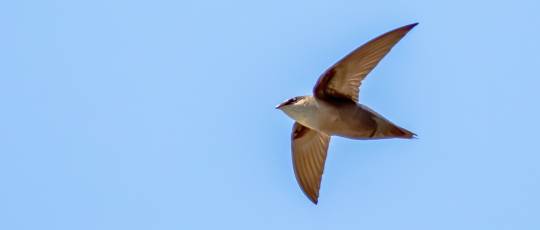
Chimney Swift (Chaetura pelagica)
From 2019 to 2020, Birds Georgia named the Chimney Swift their Conservation Focus for the year, and began an initiative to have nestboxes put out for the species across the state. Multiple towers were erected throughout the state by multiple conservation initiatives working with Birds Georgia, giving the birds more habitats outside of direct human settlements to breed and thrive in. But, why the Chimney Swift? They're sort of all over the place.
If you're from the eastern USA and walked outside in the morning or late afternoon, you've probably heard random chittering high above you, especially if you're in a city or town with chimneys on their buildings. If you look up, you've probably seen silhouettes of these guys flying at high speeds in the sky, mouths open to gather flying insects in the dawn and dusk. These are common birds all over the eastern US, as well as recognizable and easy to find and hear. So, why suggest them for Georgia? Because Georgia is tied with three other states for having the largest proportion of the breeding population for the species, at 6% of the species. Not a high number, but a significant proportion nonetheless. That makes it an intriguing choice for Georgia...and a few other places. So, this is probably not the last time we see this species on the polls.
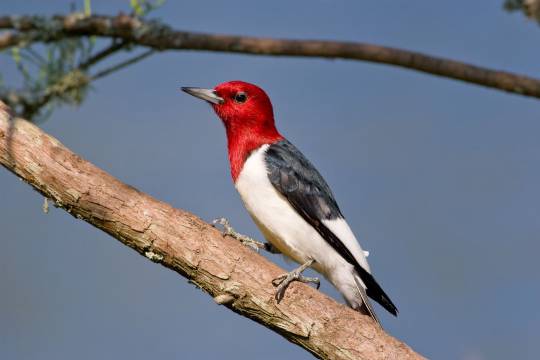
Red-headed Woodpecker (Melanerpes erythrocephalus)
But hey, if we're going for birds elevated by Birds Georgia, then we should probably highlight their actual mascot: the Red-headed Woodpecker (Melanerpe erythrocephalus). We've already talked about the importance of woodpeckers as keystone species in forested environments, and the Red-headed Woodpecker is definitely an example of that ecological role. In truth, the Pielated Woodpecker (Dryocopus pileatus), which was up for the Pennsylvania poll, actually widens holes made by the Red-headed Woodpecker for its own nest-cavities, meaning a keystone depends on a keystone.
Now, in terms of Georgia's population, the breeding population in the state is definitely not the bulwark for the species (that trophy belongs to Kansas with 11%), but the live oak forests the state is seeking to protect definitely houses the species in significant numbers state-wide. The reason Birds Georgia uses it in their logo is because, in 2014, the species was considered high-risk and on the decline in its range. As of 2022, the species is also suffering its highest region-wide decline in Georgia, tied with a few other states on that front well. Combine these facts with an iconic appearance, and the Red-headed Woodpecker is also a decent choice for State Bird from a conservation standpoint.
OK...one more. And this one's...a stretch.

Red-Shouldered Hawk (Buteo lineatus)
OK, it's not actually a stretch; I just wanted to say that because it's a tall image, and I thought it'd be funny. So, OK! The Red-shouldered Hawk (Buteo lineatus). Now, this is yet another species you can find in various places in the eastern USA, but its second largest breeding population in the country can be found in the Peach State, which is beat out by Florida. Trust me, though, Florida is one of the big three states in the South in terms of breeding bird populations. I try to get a raptor for each state, you'll notice, but why this raptor for Georgia, outside of the breeding population thing?
Well, firstly, there's the association of the species with swamps and woodlands, both of which are prominent Georgia habitats. They've got an extremely varied diet, going for most small prey items in their ranges, even weird ones like roadkill deer, crayfish, and screech owls. And while they're most common in Georgia, they're also most certainly seen in Georgia fairly commonly, especially after their recovery from DDT. But even then...why? Why have a hawk for the state of Georgia at...OK, some of you probably figured it out, I might as well just say it now.

Yup, Georgia's basketball team is the Atlanta Hawks. And yes, OBviously I could've gone for the Atlanta Falcons, but falcons make far less sense to highlight for the state, ironically. There are only three commonly seen species in the state, and none of them have Georgia as a major highlight of their breeding ranges. So, with that in mind, the Hawks seem like the team to highlight, and the best hawk for the state of Georgia is the Red-shouldered Hawk. With that said, is this really the best choice for Georgia's state bird? I mean...that's up to Georgians (and Tumblrites) to decide in the end.
So! An odd post, this one was. Some interesting choices in the end, but is this the most solid roster? Not sure. I have my guess as to the winner for this one, and honestly...it's not a bad choice if I'm right. But with that, it's time to leave it to you - the people! And the next time we have one of these posts, we'll be heading to a region and a state near and dear to me, personally. Time for the Nutmeg State, and the first state with a frequent flyer for a state bird!

See you soon, and happy birding!
Introduction to the State Birds Initiative
1. Delaware - Poll | Results 2. Pennsylvania - Poll | Results 3. New Jersey - Poll | Results 4. Georgia - Poll | Results 5. Connecticut - Poll | Results 6. Massachusetts - Poll | Results
#bird#birds#birding#birder#birders#birdwatching#bird watching#black birder#state bird#state bird initiative#georgia#birblr#birdblr#state birds initiative#brown thrasher#northern bobwhite#quail#bachman's sparrow#sparrow#swamp sparrow#savannah sparrow#brown-headed nuthatch#chimney swift#red headed woodpecker#red-shouldered hawk#hawk#atlanta hawks#bird tumblr#long post#poll
38 notes
·
View notes
Photo

Chimney Swift (Chaetura pelagica)
© Peter F
56 notes
·
View notes
Text
BOTD: Chimney Swift

Photo: Greg Lasley
"The only swift occurring regularly in the east. It once nested in hollow trees, but today it nearly always nests in chimneys or other structures. Because the bird can be easily captured and banded in such situations, it has been studied much more thoroughly than other North American swifts. In late summer, hundreds or even thousands of individuals may roost in one large chimney, gathering in spectacular flocks overhead near dusk."
- Audubon Field Guide
#birds#chimney swift#birds of north america#north american birds#birds of america#american birds#swift#swifts#birds of the us#birds of mexico#birds of central america#birds of the caribbean#birds of canada#bird#birding#bird watching#birdblr#birblr#Chaetura pelagica
20 notes
·
View notes
Text

Swift in nest, photo by Alain Gregory.

Swift on hand, photo by unknown.

Chimney Swift (Chaetura pelagica, family Apodidae), or maybe a Common Swift. Photo by unknown, via Ginger Hill on Pinterest.
6 notes
·
View notes
Text
Chaetura et al.
Batman’s daemon, they say, is a monster. One of the grotesques around Gotham given life, a gargoyle or a dragon or a stone lion. The villains who have fought him personally know the truth. Batman’s daemon is small and quick and impossible to catch, fluttering on jerky wingbeats. The only person to have ever seen Robin’s daemon is the Joker, and that was when he killed him. (Gotham’s daemons used to have the same statistics as everywhere else. That changed when Batman debuted. And it changed again when Robin did. Bats and robins were suddenly everywhere. The species of bat varied, of course, but American robins in particular seemed to win out. It stabs Bruce in the heart every time he sees it.)
rumor is that this whole fic is just a vehicle to share one of my flying squirrel fun facts. and the rumors are right.
#my writing#batman#not tagging anyone else although they're all here (minus like a couple people. for example no kate and no harper)
5 notes
·
View notes